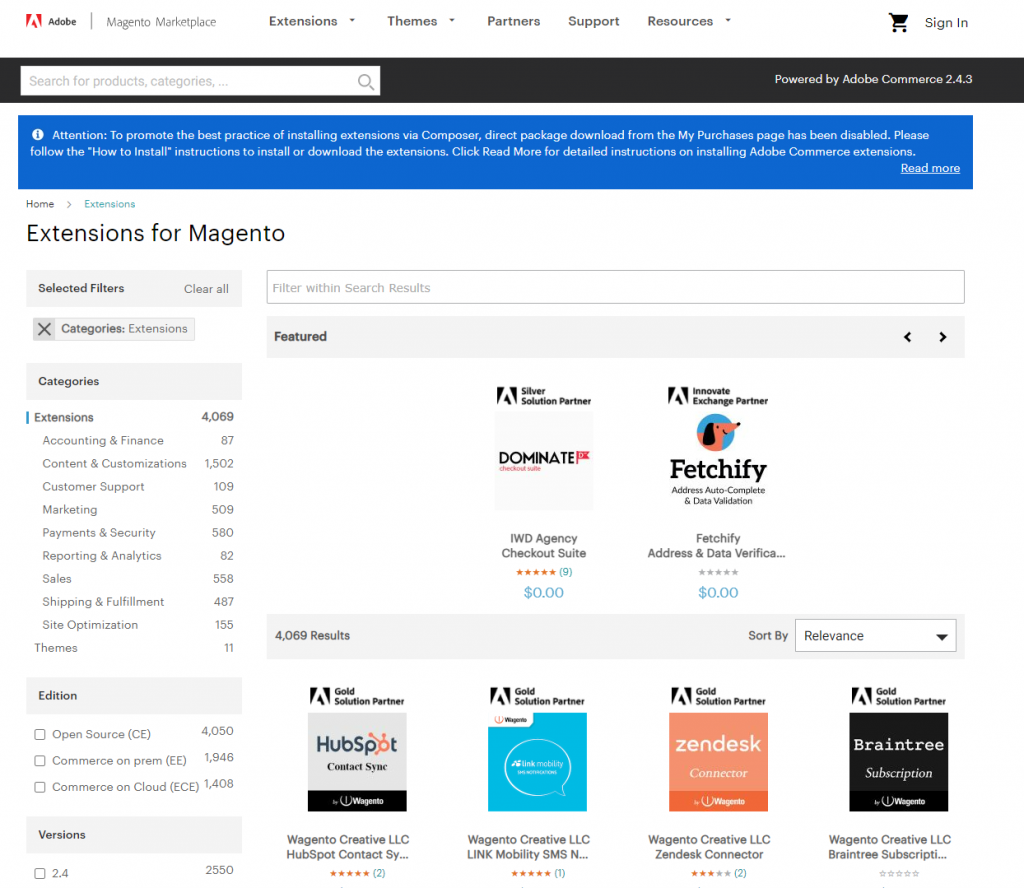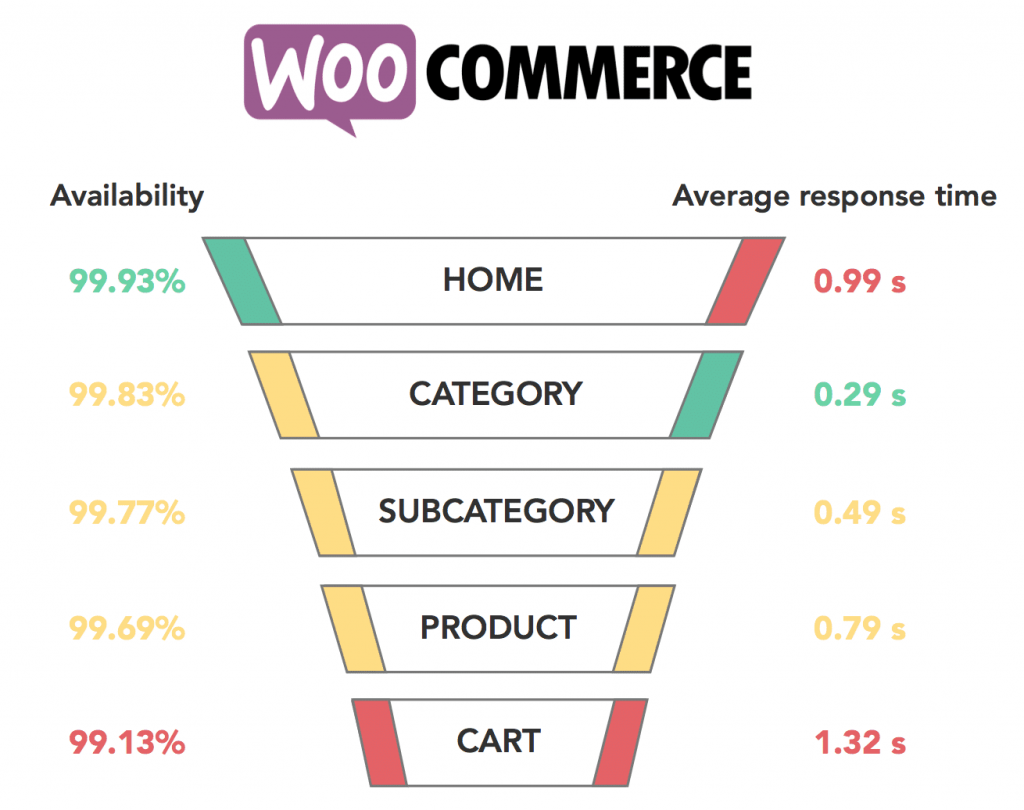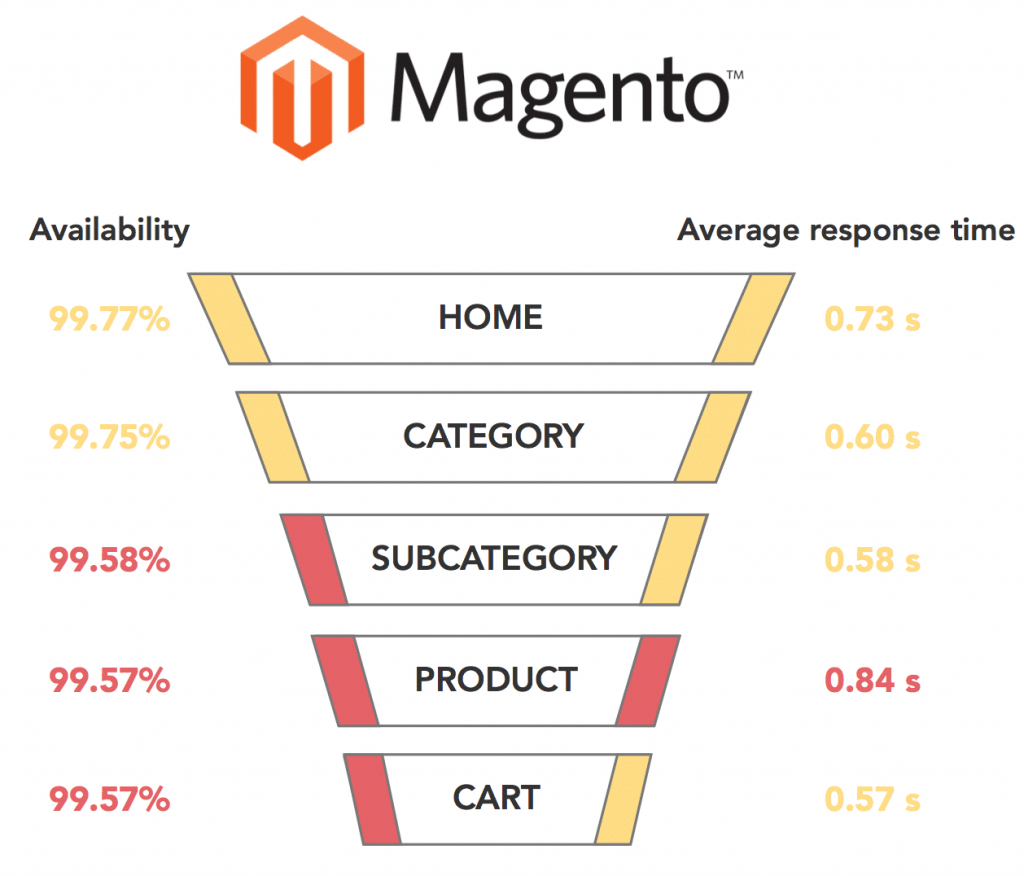So you’ve decided to start your online business and narrowed down your options to two dominating ecommerce platforms — Magento vs WooCommerce.
Indeed, both platforms can be safely considered two most popular ecommerce solutions despite the big gap in their market share. As of April 2021, WooCommerce holds 23.43% of the market, while Magento ranks lower with share of 2.32%. But wait to draw sweeping conclusions – there’s more to this than meets the eye.
In this article, you’ll get answers to all your questions about the difference between WooCommerce and Magento: their features, performance, price, and even types of merchants that will benefit the most from both solutions. Let’s dive right in!
What’s the Difference Between WooCommerce and Magento?
Before making your final choice, think about this: Magento 2 is an independent standalone ecommerce system, while WooCommerce is a WordPress plug-in that adds a few commerce operations to a content management system (CMS).
This small difference between WooCommerce and Magento affects their feature sets, performance under various traffic loads, and even ecommerce architecture. Here’s a brief overview of the two:
| WooCommerce | Magento |
|---|---|
| A free, open-source plug-in | An open-source ecommerce platform that comes in three editions: Magento Open Source (free) Magento Commerce (paid) Commerce Cloud (paid) |
| Self-hosted | Self-hosted and cloud-hosted |
| Offers a great stock of pre-built themes & extensions | Offers a decent number of pre-built themes & extensions BUT unlimited customization possibilities to build one from scratch |
| Includes basic security features | Offers advanced security features and dedicated patches |
| Easy-to-use, beginner-friendly solution | Recommended for merchants with decent knowledge of programming |
| Powers such brands as Porter and York, Sodashi, Root Science, Roberto Coin, and other small company websites. | Powers such brands as Rubik, Nike, Ford, The North Face, Nestle, among other mid-size & large company websites. |
Before we continue, why not check BigCommerce vs Magento and Magento vs Shopify comparisons?
Magento Woocommerce Comparison
The usage doesn’t state the winner. But the detailed walk through each aspect of the ecommerce platforms does. Let’s dig deeper into what WordPress WooCommerce vs Magento have to offer.
Ease of Use
The platform’s usability is one of the defining factors influenving a retailer’s choice. After all, any merchant wants to perform the administrative tasks safely, effectively, and efficiently while enjoying the experience.
The ease-of-use is the biggest benefit of WooCommerce. Because it is a plugin that you can integrate into your WordPress website to transform it into an ecommerce store, running a store becomes a breeze. Anyone familiar with WordPress even without deep technical knowledge can easily learn how to deploy and run the WooCommerce website without putting too much effort.

Moreover, WooCommerce provides a setup wizard that takes you through all the essential steps to set up your store like creating pages, choosing the language, configuring payments, and shipping methods. You only need to follow the guide and configure everything correctly.
Magento, on the other hand, may not be easy for starter entrepreneurs. Because it’s a robust standalone platform, you’ll need to possess strong coding skills to build a Magento website alone. However, it could be a little bit challenging for beginners to get started with Magento. Even though the vendor provides extensive documentation, video tutorials, and step-by-step guides, you might still need to consider hiring a Magento development company to design and support your store.

Once you’re past the store setup step, you’ll see a comprehensive Admin dashboard with advanced reporting, orders overview, SEO settings, and more — something that WooCommerce doesn’t offer. So in the end, Magento’s complexity of use is compensated with advanced functionality & analytics.
Features
The number of features of an ecommerce solution speaks volumes. To have a successful shopping site, you need more than basic functionality. It’s crucial to find a platform that offers flexibility and advanced customization options. Let’s look closer at the native features of Magento vs WordPress WooCommerce.
| Features | WooCommerce | Magento |
|---|---|---|
| Catalog Management | Unlimited number of SKUs | Unlimited number of SKUsLayered navigation, breadcrumbs, recently viewed products supported |
| Order Management | Basic order management & fulfillment features | Advanced order management, fulfillment & invoicing features |
| Checkout & Payments | Extra plug-ins & payment extensions required One-page checkout supported | 12 payment gateways supported One-page, guest, and account checkouts supported |
| Shipping | Shipping options: pickup, local delivery, shipping. Various shipping rates (flat, specific, real-time rate)Free shipping supported | Shipping to multiple addresses in one order Shopping cart with tax and shipping estimates Various shipping rates (flat, specific, real-time rate)Free shipping supported |
| Customer Accounts and Service | Customer accounts, guest checkout, one-click refunds | Customer accounts, wish lists, re-orders from accounts |
| International Support | Extra plug-in required | Built-in multi-lingual support |
| Analytics and Reporting | Basic analytics dashboard to view sales, refunds, coupons and top-performing products. | Advanced analytics & reporting dashboard + Business Intelligence in Magento Commerce and Commerce Cloud |
| Mobile-responsiveness | Extra plug-in required | Mobile commerce supported + a PWA Studio |
| B2B features | Extra plug-in required | Supported on Magento Commerce and Commerce Cloud |
| Multi-store management | Extra plug-in required | Supported |
| Marketing, Promotions, and Conversion Tool | Extra plug-in required | Supported |
| Content Management System (CMS) | Based on WordPress | Built-in CMS that can be decoupled for headless approach |
| SEO | Advanced SEO settings | Advanced SEO settings |
Take a look at the official Magento and WooCommerce websites for a complete list of features.
It’s safe to say that Magento offers many more built-in features and doesn’t require as many extensions & plug-ins as WooCommerce. The number of Magento features grows even bigger with each edition (refer to our Magento 2 Commerce vs Open Source comparison guide for more details).
So if you operate in the mid-market ecommerce, you won’t have to worry about extending your Magento store functionality. Meanwhile, small business owners will find WooCommerce features sufficient to meet their ecommerce needs.
Theme Selection
Both Magento and WooCommerce give you the possibility to design a unique storefront and provide sleek themes. There are dozens of free and paid mobile-friendly templates to select from. With a little customization, your ecommerce store should look exactly as you wish.
WooCommerce has a little advantage over Magento in terms of the number of themes available on the official marketplace. WooCommerce Themes Store provides 30+ themes, plus you can apply any of the WordPress themes.
With Magento, you have three ways to find and install a theme:
- download one from the official Magento marketplace;
- opt for themes from third-party providers such as ThemeForest or TemplateMonster;
- collaborate with a Magento development agency and design a custom-made theme from scratch to give your webstore a unique look.

Extensions and Plugins
Extensions are of great help if the native platform features are not enough. Or if you have some exquisite requirements for your webstore. Or if you want to improve user experience by enhancing your website functionality. Let’s check how well WooCommerce and Magento meet merchants’ expectations in this regard.
Being a plug-in itself, WooCommerce gathers hundreds of plugins across logistical, technical, and marketing needs. They’re all available on the WooCommerce marketplace both paid and free. Besides, you can apply the WordPress plug-ins too (the rule that works for WooCommerce themes); this way, you get access to more than 55,000 WordPress add-ons for store management, marketing, payments, shipping, and more.

Magento offers nearly 6,000 free and paid extensions on the Magento marketplace. The number looks pale in comparison with WooCommerce, but remember that much of the Magento functionality comes out of the box. You might not need to integrate as many extensions to enhance Magento functionalities. Besides, any professional agency has custom Magento extension development on its list of services, so you can get decent support anytime.

Payment Methods
An online shop won’t get many product orders if it doesn’t support secure payment methods. You need to analyze the payment preferences of your target audience and check if an ecommerce platform you are opting for supports these payment methods. Both Magento and WooCommerce have support for a wide range of payment methods.
WooCommerce supports PayPal and Stripe payment gateways by default. Merchants can also add Braintree, 2Checkout, Alipay, Amazon payments through extensions.

Magento supports 12 payment gateways, including PayPal, Braintree, Authorize.net, cash on delivery, bank transfer by default. Besides, you can integrate many popular payment gateways such as Stripe, 2Checkout, Square, Dwolla, and more as third-party extensions or via APIs.

Scalability
The holiday season is the best time to meet those sales targets. But unless your ecommerce platform can handle traffic surges, you’ll lose the sales game. Let’s see how WooCommerce compares against Magento in terms of scalability.
WooCommerce supports an unlimited number of SKUs and can handle thousands of transactions per minute. But your website speed won’t be affected only if you have powerful hosting and focus on optimizing page load time and database queries. In other words, you should take good care of the hosting if you want to see your website scale with WordPress WooCommerce.
Magento is also designed with scalability in mind and can handle up to 250,000 products in a catalog. If your sales increase by five times from one day to the next, Magento will be able to handle all the traffic easily without causing any page load problems. So the platform not only wins in the scalability category but also in Magento vs WooCommerce speed contest.
SEO
SEO can make or break your ecommerce store. When it comes to Magento vs Woocommerce SEO, both platforms will keep your website visible to search engines and to potential customers.
WooCommerce inherits most of its SEO features from WordPress. You can easily edit body content, URLs, meta descriptions, alt tags, and other page elements to optimize product pages. You can further install plug-ins to expand WooCommerce SEO capabilities if you need to.
Magento is no slacker either and offers advanced SEO tools out-of-the-box. Rich snippets on the Magento 2 catalog pages make your product data much easier to crawl by search engines. You can also easily rewrite URLs, generate meta descriptions, optimize images, or integrate your store with Google Sitemap, and much more!
Security
Security concerns are the biggest customer concern while shopping online. It’s understandable; after all, they share sensitive information such as credit card numbers, home addresses, and more. So your ecommerce platform must be constantly updated to prevent any info leaks or potential frauds.
By default, WooCommerce is a secure ecommerce plugin. There have been no known security breaches related to WooCommerce core code because of the security patches the vendor provides. However, there’s a hole through which most security issues crawl in: WordPress. According to WP White Security, 29% of sites are hacked via a security issue in their WordPress Theme and 22% via an issue in their WordPress Plugins. So you must keep an eye on the outdated themes & plug-ins as well as host your website with a secure, reliable provider.
Magento 2 has more advanced security standards in comparison to WooCommerce. Magento 2 has addressed all security concerns of Magento 1 (no wonder this version is no longer supported). The platform often releases dedicated security patches and supports such advanced technologies as Zend Framework, Composer, PHP 7, Symfony, and SSL certificate integration. A merchant can also follow our step-by-step Magento security guide to protect the website from hackers.
Speed & Performance
In the age when online shoppers drop if a website takes too long to load, e-retailers simply can’t afford an ecommerce website with poor performance. In the case of Magento vs Woocommerce, performance largely depends on the hosting provider, the size of the files, the number of extensions you add to your online store.
Regretfully, WooCommerce isn’t the fastest ecommerce solution on the market. Its average page load time reaches 776 milliseconds, and the average cart page loads in 1.32 seconds, which is beyond the “under 500 milliseconds” rule of Google. You can still fix a slow WooCommerce site by optimizing images, installing cache and performance test plug-ins, using a CDN, and finding sufficient server resources. But given the amount of work, we wouldn’t recommend WooCommerce for enterprises with a large number of products.

Being a standalone platform, Magento provides more robust and stable performance, especially when it comes to handling large catalogs. Thanks to built-in full-page caching technologies such as Varnish and NGINX, the average page loading time is 568 milliseconds, which is fast enough to retain clients until the end of the sales funnel. Besides, hosting a website on dedicated servers or in the cloud will boost Magento performance even further.

Pricing
No merchant wants to see the ecommerce platform cost eating a chunk of their total budget. That’s why Magento seems to lose in the battle against WooCommerce.
WooCommerce is a completely free plug-in. The only expenses you’ll need to consider are hosting, paid themes & plug-ins, as well as shipping and payment gateway monthly fees. If you struggle to support your store alone, you might need to hire a WooCommerce developer too.
With Magento, pricing gets a bit more complicated. Magento Open Source comes free of charge, and all your expenses will be related to Magento development, third-party systems, and monthly fees — just like WooCommerce. However, with Magento Commerce and Commerce Cloud, you’ll need to pay the license fees of $22,000/year and $40,000/year respectively. Obviously, the paid versions come with more advanced features and hosting, so you might save on the associated costs mentioned earlier.
Magento 2 vs Woocommerce Comparison Table
Before we wrap up, let’s summarize the main features of WordPress WooCommerce vs Magento in a comparison table.
| Magento 2 | WooCommerce | |
|---|---|---|
| Release date | 2008 | 2011 |
| Ease of use | Complex | Easy |
| Hosting | Self-hosted and cloud-based | Self-hosted |
| Extensions | 6,000 | 55,000 |
| Features | Advanced | Basic |
| Ease of Integration | Flexible | Flexible |
| Payment Gateways | Supports PayPal, Braintree, Authorize.net by default | Supports PayPal, Stripe by default |
| Customizability | High | High |
| SEO | Advanced | Basic |
| Security | Magento is PCI compliant. Supports advanced security and updates | WooCommerce is PCI compliant |
| Multilingual capabilities | Built-in multi-lingual support | With Plugins |
| Support | Magento Open Source doesn’t include support and Magento Commerce offers 24/7 customer support | No |
| Available Devices | Windows, Android, iPhone/iPad, Mac, Web-based | Windows, Android, iPhone/iPad, Mac, Web-based |
| Ideal Ecommerce Size | Medium-sized and large businesses with a high-volume store | Small businesses looking for a user-friendly platform |
| Pricing | Free for Magento Open Source $22,000+/year for Magento Commerce Edition (Enterprise)or $40,000+/year for Magento Cloud Edition | Free |
Which Is Better: Woocommerce or Magento?
At the end of the day, it is up to you to decide whether WooCommerce or Magento is the best option for your ecommerce business. Generally, it’s not about what you require today but about your future plans to scale.
WooCommerce is a perfect fit for small businesses that are looking for a flexible, cost-effective, and user-friendly solution. Its smooth integration with WordPress allows ecommerce businesses that are already using WordPress to start selling right away.
WooCommerce ideal merchant:
- A small business or a content-heavy website that already runs on WordPress
- Searches for a platform with a wide range of free plugins available
- Needs basic security features
- Wants to build content-heavy commerce sites at low cost
- No IT team to maintain and support the website
Magento is a perfect fit for mid-sized and large businesses that are looking for a strong order management framework, great customization, high scalability, advanced security, and a full range of built-in features. If you expect a high volume of traffic, Magento should be a top choice for you.
Magento ideal merchant:
- An ambitious ecommerce business that has a large catalog and B2B requirements
- Requires advanced customization of website design and functionality
- Has in-house IT team to maintain the Magento store
- Requires advanced security features
- Planning to scale and expects to have large product catalogs.
Migrate WooCommerce to Magento: Elogic Expertise
What if you choose WooCommerce now and later decide to migrate to Magento when your store scales? Or what if you decide to migrate now?
With Elogic, you can fulfill all your ecommerce migration ambitions in a time- and cost-effective way. The WooCommerce to Magento 2 migration process consists of four simple steps:
- Gather all your business requirements and import products, customer info, and order data from WooCommerce to Magento 2.
- Migrate and expand the WooCommerce functionality in a new Magento environment.
- Redesign your website theme so that you don’t experience any security issues discussed above ever again.
- Deploy the Magento website at night or during weekends to achieve minimum downtime and maximum productivity.
That’s what we did for our Swiss client, Glassmania. The online glassware retailer significantly expanded website functionality as well as implemented custom ERP and other third-party system integrations. Replatforming to Magento boosted user experience, especially after a product configuration feature (something that was impossible to do in WordPress WooCommerce).

Visit our projects page for more success stories of our clients and consider Elogic as your future ecommerce partner.
Collaborate with a certified Magento development agency for better and faster results
Migrate WooCommerce to Magento now
